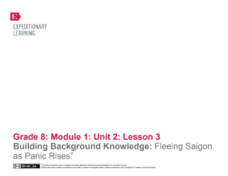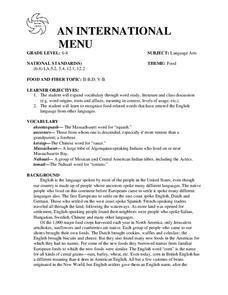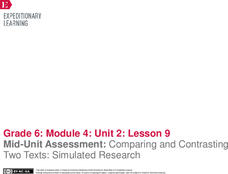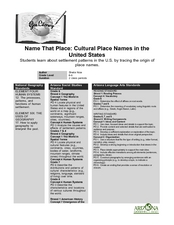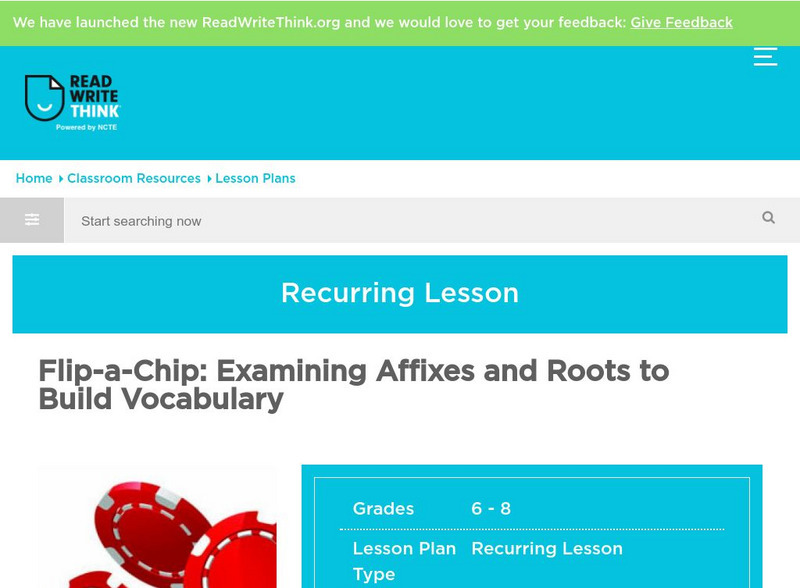EngageNY
Close Reading: The Introduction to the Universal Declaration of Human Rights
As part of a group of lessons, your class will return to the primary text for this unit, the Universal Declaration of Human Rights. Key vocabulary as well as close reading strategies continue to be the focus skills; however, this lesson...
Curated OER
Using Word Maps to Expand Vocabulary
Looking for a good lesson on dictionary and word definition skills? The lesson presented here is for you! In it, learners utilize a worksheet, embedded in the plan, to record a word's definition(s), etymology, multiple meanings,...
Curated OER
Decoding Strategies
Learners practice using context clues to decode the meanings of unfamiliar words. In this vocabulary skills lesson, students follow the provided instructions to complete graphic organizers that enable them to decode words in "The...
Curated OER
Using Context
Teams practice decoding and using context strategies to determine the meanings of unfamiliar words. After verifying the meanings of words through the use of dictionaries, the Internet, thesauruses, and other sources, learners write the...
Curated OER
Vocabulary Building Cards
Students select vocabulary words from their reading each week then complete a card for each word which includes definition, source and a sample sentence. They share their cards with the class and complete vocabulary building cards...
Curated OER
Suffixes
Eighth graders determine the meaning of vocabulary words using linguistic roots and affixes. In this vocabulary lesson, 8th graders discuss examples of suffixes and their meanings. Students find the root words and suffix from a list of...
EngageNY
Summarizing Complex Ideas: Comparing the Original UDHR and the "Plain Language" Version
The eighth lesson plan in this series continues the focus on vocabulary and increasing young readers' awareness of academic language. Pairs of learners participate in a short vocabulary review activity called Interactive Words in which...
EngageNY
Building Background Knowledge: "Fleeing Saigon as Panic Rises”
How can scholars better understand the refugee experience? Pupils read Fox Butterfield's article "Panic Rises in Saigon, but the Exits are Few" and connect it to the novel Inside Out & Back Again. They annotate the text, looking for...
Curated OER
AN INTERNATIONAL MENU
Studentsl expand vocabulary through word study, literature and class discussion (e.g. word origins, roots and affixes, meaning in context, levels of usage, etc.). They recognize food-related words that have entered the English language...
Curated OER
Context Clues
Students practice identifying the meanings of unknown words using context clues. In this vocabulary lesson, students read sentences which contain an unknown words. They will use the context of the sentence to determine the meaning.
EngageNY
Mid-Unit Assessment: Comparing and Contrasting Two Texts: Simulated Research
Shoo fly. Scholars read DDT Spray Scares Mosquitoes Away, Study Finds and You Think You Have It Tough? to complete a mid-unit assessment. The learners compare and contrast author presentation and conduct a credibility check on each...
Curated OER
Using a Dictionary
When do we use dictionaries? Provide this dictionary scavenger hunt for your youngsters. Third and fourth graders search for words, recording the number of syllables or definition for a variety of words. Get your class using dictionaries...
Curated OER
Using A Dictionary
Students explore English by completing a word definitions worksheet. In this dictionary lesson plan, students practice locating a list of vocabulary terms in a "Dictionary Race." Students complete a worksheet based upon word cards and...
Hawaiʻi State Department of Education
Making Dances From Stories
After reading a short story, learners will create dances that show homophones and verbs. Their dance sequences involve three verbs and transition movements in between each verb. Tip: Have the class dance out the sequence of events from...
Curated OER
Food Pyramid Menu
Students analyze the food pyramid. In this food pyramid instructional activity, students evaluate their nutritional needs. Students record their eating habits and determine if their food choices were healthy.
Alabama Learning Exchange
Echolocation Stations: Exploring Sound
Fourth graders explore the concept of echolocation during a unit on whales. They listen to the book and watch the Reading Rainbow video for "Humphrey: The Wayward Whale," explore various websites, and conduct experiments to demonstrate...
Curated OER
Name That Place: Cultural Place Names in the United States
Students examine the origin of the people that settled in the United States. In this United States History lesson, students work in small groups to complete several activities that explore early settlement, such as a worksheet, a...
Curated OER
Centipede or Millipede?
Students discuss millipedes and centipedes in terms of their classification as arthropod. Using a diagram, students categorize and compare and contrast the characteristics of millipedes and centipedes based on their discussion of...
ReadWriteThink
Read Write Think: Improve Comprehension: A Word Game Using Root Words and Affixes
Contains plans for three lessons that teach about root words, prefixes, and suffixes using handouts, websites, and games. In addition to objectives and standards, this instructional plan contains links to sites used in the lessons as...
Utah Education Network
Uen: It's Greek to Me!
This lesson engages young scholars in vocabulary-building strategies related to Greek and Latin roots. Students will be given charts with Greek and Latin roots. Young scholars will practice combining different roots to form present-day...
ReadWriteThink
Read Write Think: Flip a Chip: Examining Affixes and Roots to Build Vocabulary
Contains plans for a vocabulary activity that uses an activity called Flip-a-Chip to teach about affixes. In addition to objectives and standards, this instructional plan contains links to sites used in the activity as well as assessment...







